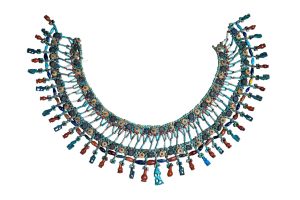Beaded Collars
Beaded Collars From The Grave Of An Amarna Princess ?

The Egypt Centre has four beaded collars which, it has been suggested, were found in the grave of an Amarna princess. They are number W8-W11.
Most would agree that the amulets on the collars date to the Amarna Period, however, there is discussion as to whether or not the stringing is genuine.
Three of the collars have pendant amulets suspended from them. W8 has a floral amulet (or possibly an oyster shell), W9 a possible Beset amulet and W10 a heart amulet.
One of the most popular amulets from Amarna was that of the dwarf god Bes. W9, has an unusual depiction of Bes and it has been claimed that this shows Beset, a female Bes figure.
The collars have no proven provenance and yet for many years have resided in the University of Wales Swansea stating that they were from a princesses’ grave. The idea that these collars come from a princesses’ grave derives largely from the fact that they are obviously from a rich tomb, that the style of some of the beads and amulets are similar to those from Amarna and that a rich tomb was pillaged in the Amarna area in the 1880s (Blackman 1917, 45-46). The collars were purchased by Mrs Berens in the 1880s and later purchased by Sir Henry Wellcome. However, the 1880s tomb itself not only contained fragments of sarcophagus with the names of Amarna princesses but also the name of Akhetaten and Amenophis III (Martin 1974) and the evidence for their having coming from the Amarna tombs remains circumstantial.
That the collars belonged to females is supported by the fact that some of the amulets particularly the Beset (?), fish, and nasturtium/melon seeds (the type of seed is not clear) are associated with females, although since there are so few comparable pieces of jewellery, statistically the associations may be meaningless. Nasturtium/melon seed beads and fish amulets were found associated with burials of the wives of Tuthmosis III. One of the collars also carries what could be interpreted as an oyster shell, though alternatively it may represent floral decoration. (Bosse-Griffiths 1977, 98) saw it as a ‘fan’. Gold oyster shells have been found on the jewellery of Princess Khnumet from Dashur and among the treasures of Meret, Sithathor, Senebtisy and Nubhotepti. They are also usually shown in Egyptian representational art around a woman’s neck (Andrews 1994, 43). However, the pectoral of Tutankhamun has fish amulets on it so these are not exclusively female associated objects. Other amulets upon the collars, such as the heart amulet, can be associated with either men or women. See if you can also see the baboon amulet, the man with a stick or sceptre amulet and the cornflower/poppy head amulet, a squatting child with a finger in its mouth? The collars also have a number of rosette beads.
One would expect such collars as these to have faience terminals. Terminals can be seen on the cartonnage collars in ‘The House Of Death’ (the downstairs gallery in the Centre). However, the terminals may have been cut off the ‘Amarna’ collars and sold separately.
Broad collars seem to have been a common feature of Egyptian dress. However, it is unusual to find collars with the thread still intact. Often dealers made up collars with beads from a variety of sources and often of different dates. It is possible that the same has been done with ours. However, the beads do seem to date to the same period, the 18th Dynasty, which reinforces the idea that the thread is genuine. In addition, the thread is linen. The ancient Egyptians used linen whereas modern forgers tended to use cotton.
We have considered having the thread radio-carbon dated but this would destroy the thread. Additionally, if the thread were found to be ancient this still would not prove that the collars were not made up in Victorian times.
Close-up of man with stick amulet
Close-up of squatting king, heart and woman with staff
Other Amarna amulets in the Egypt Centre
Further Reading
Andrews, C., 1994. Amulets Of Ancient Egypt. British Museum Press.
Blackman, A.M., 1917. ‘The Nugent and Haggard Collections’. The Journal of Egyptian Archaeology, 4, 39-46.
Bosse-Griffiths, K., 1975. Bead Collars With Amarna Amulets In The Welcome Collection of University College, Swansea. Égyptologie, 1, 20-24.
Bosse-Griffiths, K., 1977. ‘A Beset Amulet From The Amarna Period’. The Journal of Egyptian Archaeology, 63, 98-106.
Györy, H., 1998 Remarks on Amarna Amulets in C.J. Eyre ed. Proceedings of the 7th International Congress of Egyptologists September 1995. Leuven Peters 497-507.
Martin, G., T., 1974. The Royal Tombs at El-Amarna. I London.
Ward, W.A .,1972, A Unique Beset Figurine, Orientalia 41, 149-159.